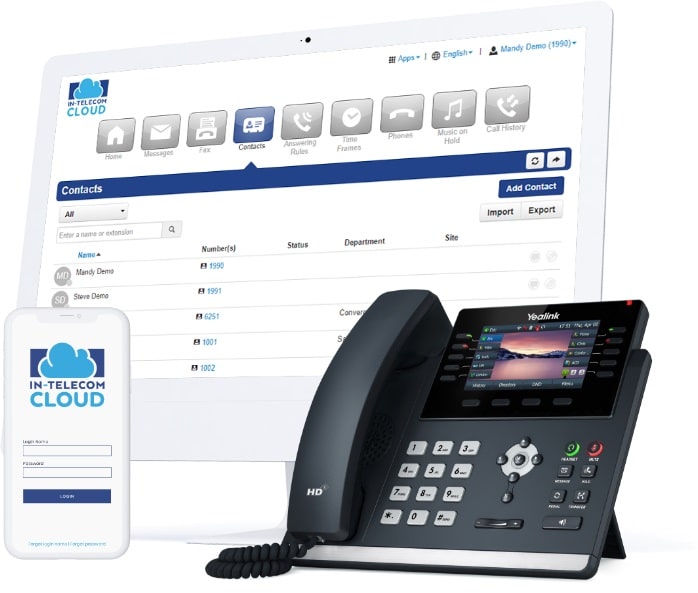
Learn How to set up a VoIP phone at your business or home. VoIP (Voice over Internet Protocol) has been around for a long time, gaining popularity as early as the year 2003 with the first release of Skype. In contrast to traditional telephones, VoIP setups use the internet to connect with other devices and networks.
Modern VoIP technology is surprisingly easy to install, and it works the same as (if not better than) the typical connection on a cell phone or landline. Another bonus of a VoIP phone service at work or at home is access to a wider range of features while saving a significant amount of money on your phone bill.
In this guide, we’ll walk you through the steps involved in setting up a VoIP phone service for your business or home.
- Test Your Internet Bandwidth And Speed
- Invest In The Right VoIP Hardware (https://www.in-telecom.com)
- Find a VoIP Phone Service Provider with the Right Features
- Get A Business Phone Number
- Set Up Your VoIP Phone System
- Test Your New VoIP Line
- Train Your Staff to Get The Most Out of VoIP Features
VoIP is simple to set up and works well on most broadband connections. With that in mind, there isn’t much prep work involved other than confirming that your internet is strong enough for the demands of a VoIP phone system.
If you’re setting up VoIP at home, you shouldn’t have to worry about the strength of your connection. Conversely, if you’re interested in configuring VoIP for your business, you may need a substantial increase in bandwidth.
Unfortunately, it’s hard to say exactly how much you need without testing the system out. We have helpful guidelines for VoIP bandwidth, but the right amount depends on several factors, including the total number of concurrent calls and the codec used to encode and compress vocal inputs.
Depending on your provider, you may be able to upgrade your bandwidth as needed after installing VoIP.
Step 1: Get the right hardware
You don’t need too much specialized gear to get started with VoIP. That said, there are a few purchases that can make things.
A VoIP phone gives you the experience of a traditional phone while using VoIP plus many additional features. VoIP phones are available from a wide range of brands and with a variety of unique features. In-Telecom, for example, sells VoIP phones that can have dozens upon dozens of lines.
VoIP phones typically connect to networks through an Ethernet cable. It’s technically possible to run VoIP over a Wi-Fi connection, but hardwired connections tend to be faster and more reliable.
On the other hand, a physical phone isn’t strictly necessary for a VoIP system. Digital phone apps like with ITC Cloud offer the experience of VoIP without any additional hardware, and these services are typically affordable.
Step 2: Find a VoIP provider
With so many VoIP providers out there, it can be tough to tell which one is right for you or your business. Different options come with different pricing and offer vastly different sets of features, so you should take the time to compare at least a few providers before committing to a subscription.
One key factor to consider in a new VoIP service is whether they charge by the user, by the minute, or a combination of both. You may also need to weigh the benefits of advanced features against the additional costs.
At the end of the day, the only way to find the “best” VoIP phone service provider for your business is to look at a few promising options and compare them in terms of both features and pricing. Some organizations save money by using VoIP exclusively for calling outside numbers, while others prefer to invest in an all-in-one solution for VoIP calls, as well as internal meetings and other forms of communication.
Step 3: Connect your equipment and get started
Once you have the tools and necessary software that you need to get started with VoIP, you’ll be ready to put everything together and get the system up and running.
Of course, the specific steps will vary depending on your setup—you might need to connect your existing phones to VoIP adapters or replace them with VoIP phones. Similarly, some IP phones and routers support power over Ethernet, allowing you to power the phone and connect to the internet with a single Ethernet cable.
In-telecom, for example, has pre-configured phones that will work with VoIP after being connected to the internet. You’ll simply plug it in to your router via Ethernet and wait for it to show up in your VoIP software.
Setup should go effortlessly for most users, but you may run into technical problems or other unexpected issues. Again, it’s best to check with the manufacturer of the product that’s malfunctioning if you’re having trouble with your VoIP setup. It will be able to offer more specific instructions based on the hardware and software you’re using, and many VoIP service providers have detailed guides for both setup and general use.
Get a Free VoIP Phone Service Quote
Our expert team and certified partners can help you find the best VoIP partners for your business, saving you time and money, by choosing the most competitive offer. Our service is 100% FREE with NO obligation to buy.
Here’s how it works:
- Tell us about your business requirements and leave your contact details.
- We match your requirements with features and prices.
- One of our customer service reps will reach out to you ASAP.





